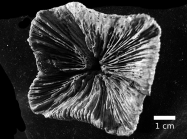
Chinese
Register of
Marine Species
(ChaRMS)
Register of
Marine Species
(ChaRMS)
| Intro | | Search taxa | | Taxon tree | | Sources | | Statistics | | Editors | | Log in |
WoRMS taxon detailsScolymia Haime, 1852
204384 (urn:lsid:marinespecies.org:taxname:204384)
accepted
Genus
Madrepora lacera Pallas, 1766 accepted as Scolymia lacera (Pallas, 1766) (type by subsequent designation)
Lithophyllia Milne Edwards & Haime, 1857 · unaccepted > junior subjective synonym
marine,
Haime, J. (1852). Polypiers et bryozoaires. In: Bellardi, L. Catalogue raissoné des fossiles nummulitiques du compté de Nice. <em>Mémoires de la Société Géologique de France, Série 2.</em> 4 (2): 279-297, pl. 22. [details]
Description Corals are usually monocentric, rarely polycentric. Secondary centres may occur inside or outside the original calice and...
Description Corals are usually monocentric, rarely polycentric. Secondary centres may occur inside or outside the original calice and calices may divide. Walls are indistinct beneath the septo-costae. Septa slope evenly, with little fusion. Primary septa have large, regular, blunt teeth. Columellae are broad and compact. Polyps are extended only at night. (Veron, 1986 <57>) [details]
Hoeksema, B. W.; Cairns, S. (2024). World List of Scleractinia. Scolymia Haime, 1852. Accessed through: World Register of Marine Species at: https://www.marinespecies.org/aphia.php?p=taxdetails&id=204384 on 2024-09-24
Date action by
original description
Haime, J. (1852). Polypiers et bryozoaires. In: Bellardi, L. Catalogue raissoné des fossiles nummulitiques du compté de Nice. <em>Mémoires de la Société Géologique de France, Série 2.</em> 4 (2): 279-297, pl. 22. [details]
original description (of Lithophyllia Milne Edwards & Haime, 1857) Milne Edwards H, Haime J. (1857). Histoire naturelle des coralliaires ou polypes proprement dits 2. Librairie Encyclopédique de Roret, Paris. 631 pp., available online at https://www.biodiversitylibrary.org/page/12403706 [details] context source (Hexacorallia) Fautin, Daphne G. (2013). Hexacorallians of the World. (look up in IMIS) [details] basis of record Veron JEN. (1986). Corals of Australia and the Indo-Pacific. <em>Angus & Robertson Publishers.</em> [details] additional source Randall RH. (2003). An annotated checklist of hydrozoan and scleractinian corals collected from Guam and other Mariana Islands. <em>Micronesica.</em> 35-36: 121-137. page(s): 134 [details] additional source Steiner, S.C.C., 2003. Stony corals and reefs of Dominica. Atoll Res. Bull. : 497-508. page(s): 5 [details] additional source Cairns, S.D., J.C. den Hartog & C. Arneson. (1986). Class Anthozoa (Corals, Anemones). <em>In: Sterrer, W. (ed.). Marine fauna and flora of Bermuda, John Wiley and Sons, Inc., New York, USA.</em> pp. 159-194. page(s): 185, 186 [details] Available for editors additional source Veron JEN, Pichon M. (1980). Scleractinia of Eastern Australia – Part III. Family Agariciidae, Siderastreidae, Fungiidae, Oculinidae, Merulinidae, Mussidae, Pectinidae, Caryophyllidae, Dendrophylliidae. <em>Australian Institute of Marine Science Monograph Series.</em> 4: 1-459. [details] additional source Veron JEN. (2000). Corals of the World. Vol. 1–3. <em>Australian Institute of Marine Science and CRR, Queensland, Australia.</em> [details] additional source Wells JW. (1964). The recent solitary mussid scleractinian corals. <em>Zoologische Mededelingen, Leiden.</em> 39: 375-384. [details] additional source Brüggemann, F. (1877). Notes on the stony corals in the collection of the British Museum. III. A revision of the Recent solitary Mussaceae. <em>Annals and Magazine of Natural History, Series 4.</em> 20: 300-313. [details] additional source Budd AF, Woodell JD, Huang D, Klaus JS. (2019). Evolution of the Caribbean subfamily Mussinae (Anthozoa: Scleractinia: Faviidae): transitions between solitary and colonial forms. <em>Journal of Systematic Palaeontology.</em> 17(18): 1581-1616., available online at https://doi.org/10.1080/14772019.2018.1541932 [details] additional source Barrios-Suárez, L. M.; Reyes, J. O.; Navas, G. R.; García, C. B. (2002). Distribution of anemones (Anthozoa: Actiniaria and Corallimorpharia) in the area of Santa Marta, Colombian Caribbean [Distribución de las anémonas (Anthozoa: Actiniaria y Corallimorpharia) en el área de Santa Marta, Caribe columbiano]. Ciencias Marinas, 28(1): 37-48 page(s): 40-41 [details]  Present Present  Inaccurate Inaccurate  Introduced: alien Introduced: alien  Containing type locality Containing type locality
Nontype (of Lithophyllia Milne Edwards & Haime, 1857) BMNH, geounit Chinese Exclusive Economic Zone [details]
From editor or global species database
Remark Scolymia was synonymized with Mussa in Wells 1956 (p.F418), but was later removed from synonymy in Wells (1964, p.381). Veron (2000) designated Madrepora cubensis Milne Edwards and Haime 1849 as the type species of Scolymia, after synonymizing Scolymia lacera (Pallas, 1766) with Mussa angulosa (Pallas, 1766). [details]From other sources
Description Corals are usually monocentric, rarely polycentric. Secondary centres may occur inside or outside the original calice and calices may divide. Walls are indistinct beneath the septo-costae. Septa slope evenly, with little fusion. Primary septa have large, regular, blunt teeth. Columellae are broad and compact. Polyps are extended only at night. (Veron, 1986 <57>) [details]Remark Type species: Madrepora lacera Pallas, 1766 from the Caribbean (Veron, 1986). [details]
|

